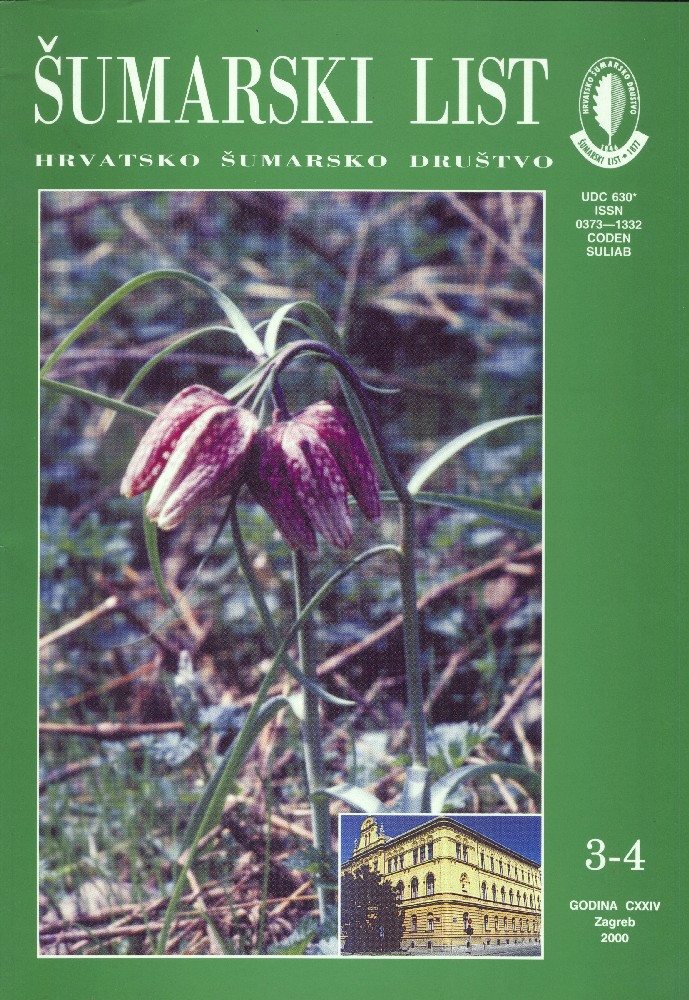
broj: 3-4/2000
pdf (37,7 MB) |
|
||||||||||||||
| IZVORNI ZNANSTVENI ČLANCI | ||
| Šalek-Grginčić, J. | UDK 630* 622 + 624 (Quercus petraea Liebl.) | |
| Regulation of Private Forests of Sessile Oak (Quercus petraea Liebl.) in the Area of the Karlovac Forest District pdf HR EN | 123 | |
| Pintarić, K. | UDK 630* 232.1 (Larix europaea) 001. | |
| 30 Years of Research Into Larch of Various Provenances in Bosnia pdf HR EN | 143 | |
| PREGLEDNI ČLANCI | ||
| Molak, B. | UDK 621.31 | |
| Unnecessary Environmental Pollution and Impoverishment of the Population in the Production of Electrical Energy pdf HR EN | 157 | |
| Sabadi, R. | UDK 630* 904 | |
| France: Forests of the Overseas Departments pdf HR EN | 171 | |
| STRUČNI ČLANCI | ||
| Božić, M. | UDK 630* 524 (Abies alba Mill.) | |
| What is the Real Amount of Fir Stocks in Croatian Forests? pdf HR EN | 185 | |
| Böhm, D. | UDK 630* 907.1 + UDK 551.48 | |
| Regressions in the Water Zone of the National Park Plitvička Jezera pdf HR EN | 197 | |
| Summary: The author gives a detailed explanation of the beginning and course of ageing of the Plitvice Lakes, a gem of protected nature in the category of national parks. This area has been listed into the world natural heritage, run by the UNESCO in Paris. The Plitvice Lakes are karst lakes on the substrate of dolomite and lime in the category of travertine terraced lakes with numerous waterfalls and cascades. They belong to a younger geological period and were formed after the latest glacial period. However, there are clear indications and proofs that the oldest travertine formations belong to the period before the penultimate glacial period. The ageing of the lakes is the result of long-lasting natural erosion of the surface and petrographic substrate. This process has been accelerated by the activities of the man and particularly by large-scale cutting of natural virgin forests on karst, whose protective role enabled the formation and evolution of the lakes, and with whom they created a unique ecological macro-system. The regressive process is rapidly spreading from the beginning to the end of the water zone and represents an invaluable loss in both Europan and world standards. Since the end the Second World War, the Plitivice Lakes have been intensively and ruthlessly exploited by the tourist industry. The overburdened nature, the misguided building of roads through the very heart of the National Park, the hotels located in inappropriate places and enormous numbers of tourists have resulted in a worrying situation. The poor state of the area is further aggravated by waste water, which threatens the Lower Lakes and the River Korana. The author proposes urgent measures to repair the condition, the use of excavator-refueller and deposit removal. The starting point is the realisation that the situation cannot be repaired fully, but the ageing process can be mitigated, that is, postponed for a longer period. With regard to considerable quantities of deposits, the removal operation will certainly take a long time. The treatment does not allow any postponement. The authorised government bodies should embark on the action immediately, and assistance from international expert institutions is welcome. | ||
| Dimitrov, T. | UDK 630* 432 | |
| Future Wildfires Related to the Global Warming pdf HR EN | 203 | |


